Experiment ZR012 by C3H5N3O9 a.k.a. MB&F and URWERK
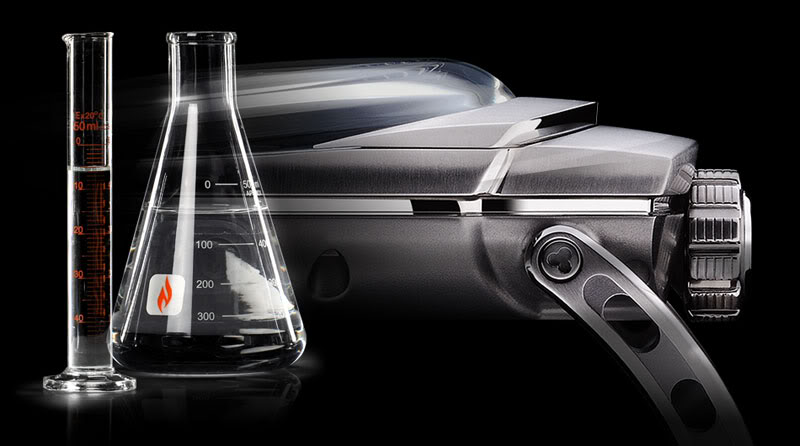
The cooperation between two of the world’s most innovative watch brands is unique and the result is simply awesome! Whether we call Experiment ZR012 a love baby of MB&F and URWERK or their bastards child, the creation under the name C3H5N3O9 brings together the best of both masterminds of the contemporary watch world.
One plus one is… three. I know, mathematically that isn’t correct. However, a cooperation like this could easily result in something less than the sum, in this case it has lead to something explosive… C3H5N3O9 is not only the name of this horological experiment, it’s also the molecular formula for nitroglycerine!

The idea
The first ideas started when Felix Baumgartner and Maximilian Büsser had lunch on a Geneva terrace in the summer of 2008. URWERK founders, Felix Baumgartner and Martin Frei had a concept featuring Wankel engine inspired indications, that they had not yet developed, and they suggested that their constructor Cyrano Devanthey could develop and produce a movement based on that.
MB&F partners Maximilian Büsser and Serge Kriknoff teamed up with independent watch designer Eric Giroud (responsible for the design of several MB&F timepieces and those of Heritage Watch Manufactory) to design and produce the case. Experiment ZR012 was born and according to the website, they are no luxury brand, they are an experimental platform. I’m curious if this will lead to more mind-blowing experiments, however let’s first have a look at the ZR012!
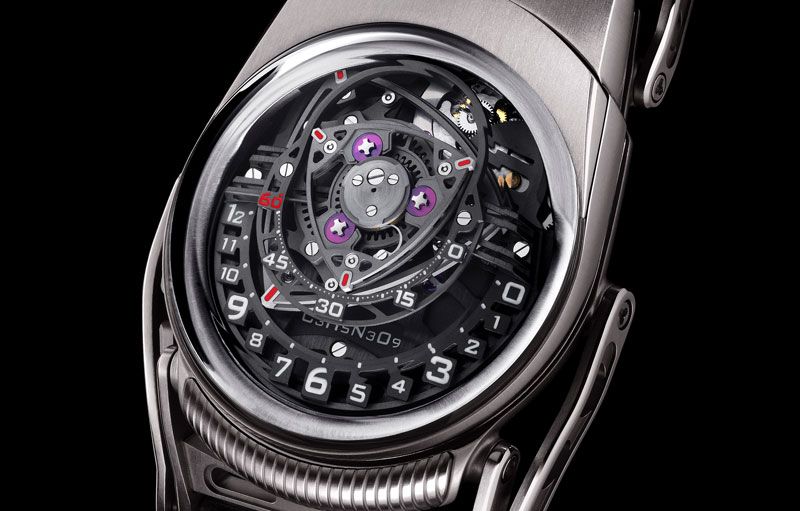
Background information
So, let’s move on to the mechanics. The hour and minute indication is inspired by a Wankel engine. The Wankel engine was developed in 1919, by the 17-year-old German boy called Felix Wankel. Five years later Felix created a small laboratory to develop his rotary engine and eventually tested the first prototype in 1957, over three decades after his first designs.
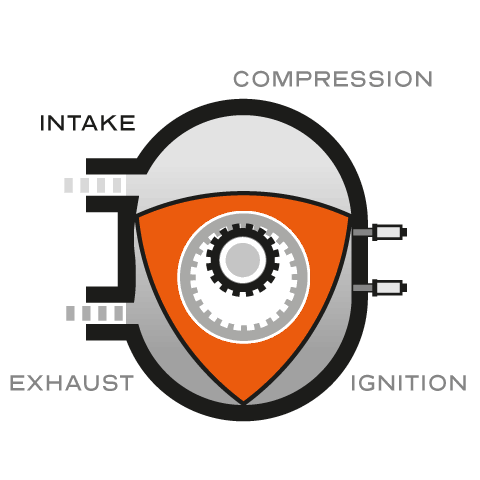 The Wankel engine is based on a convex-triangle rotor that rotates inside an epitrochoid combustion chamber. Because an epitrochoid is a very complex shape it involves seriously complex mathematics, to figure out the exact dimensions and shapes. From over 800 shapes considered, Wankel investigated nearly 150 configurations and variations before finding the optimum solution. This was of course far before there were computers!
The Wankel engine is based on a convex-triangle rotor that rotates inside an epitrochoid combustion chamber. Because an epitrochoid is a very complex shape it involves seriously complex mathematics, to figure out the exact dimensions and shapes. From over 800 shapes considered, Wankel investigated nearly 150 configurations and variations before finding the optimum solution. This was of course far before there were computers!
Many cars brands (Alfa Romeo, American Motors, Citroen, Ford, General Motors, Mercedes-Benz, Nissan, Porsche, Rolls-Royce, Suzuki, Toyota and even Rolls Royce) signed licensing agreements to develop their own Wankel engine, however it appear rather difficult to produce a good working version.
Also Norton Motorcycles developed a Wankel rotary engine for motorcycles, which was included in their Commander and F1. Mazda and NSU signed a study contract to develop the Wankel engine in 1961 and competed to bring the first Wankel powered automobile to market. It was NSU who was first with a Wankel automobile on sale, the sporty NSU Spider in 1964, however they seemed to have problems with a seal. It was actually Mazda who successfully deployed a Wankel engine in the 1967 Cosmo 110S. Doesn’t this car look out-of-this-world-cool?
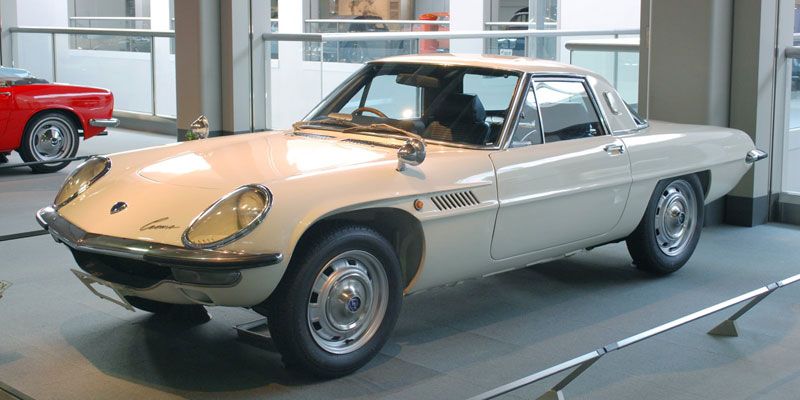
Mechanics
Wankel was the first to use an epicyloid in an internal combustion engine; Experiment ZR012 is the first to use an epicyloid indications in a wristwatch. At first glance the time appears to be indicated by centrally rotating triangular rotors. However, the triangles are actually so-called Reuleaux triangles; they rotate eccentrically rather than centrally and track complex epitrochroid curves rather than circles, like in the Wankel engine.
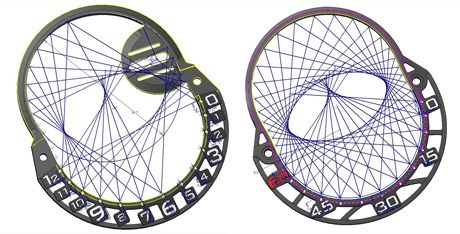
To create the complex shape of the hour and minute epitrochroid curves with the high precision required, 180 separate points were plotted. There is tolerance of just o.2omm between the triangular rotors and the hour and minute marked epitchroids surrounding them.
The Reuleaux triangle shaped rotors are eccentric, meaning they are NOT not mounted directly to the central pinion that usually holds the hands. Setting this up correctly in assembly demands considerable time, skill and patience!
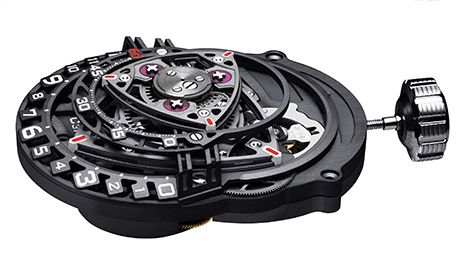
At these minuscule dimensions, the thickness of one tooth on the gears is not fine enough to precisely align the hour and minute wankels – normally you adjust by a complete tooth. To ensure extremely high precision adjustment, the fixed wheels can be rotated slightly (then re-fixed) to allow fine adjustment and synchronized precision between the hour and minute indicators.
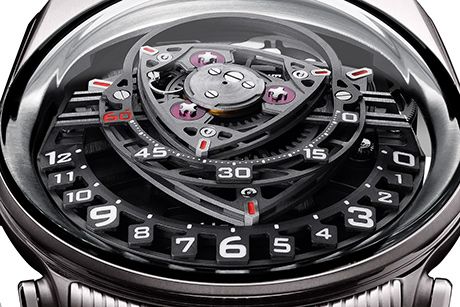
Indication of hours and minutes
Experiment ZRO12 indicates hours and minutes with two Wankel engine eccentric rotating Reuleaux triangle-shaped rotors. Hours are indicated by the lower rotor and the ‘corners’ of the hour rotor have short red stripes that indicate the actual hour along the front of the ‘dial’.
Minutes are indicated by the smaller upper rotor, that also features short red stripes at each ‘corner’ to indicate the minutes along the minute index scale.
Case and lugs
The case of Experiment ZR012 is made of zirconium. Visually zirconium is similar to titanium and is highly resistant to corrosion. The lugs are in titanium. The articulated front lug and compound rear lug are designed to wrap ergonomically around the wrist and ensure a high level of comfort. Something we have seen before on the MB&F Horological Machine 4 and from experience I can tell this indeed work perfectly. The case dimensions are quite significant, with 55mm x 44mm (excluding lugs), which makes makes it even more important that MB&F and designer Eric Giroud paid attention to the level of comfort.

A power reserve indicator is visible on the reverse side of the case and indicates how much of the 39 hours of autonomy are left before ZR012 has to be wound again.
Price and availability
Experiment ZR012 is limited to 12 pieces in Zirconium that will be available this year. Next year, 2013, C3H5N3O9 will produce 12 pieces in red gold. Experiment ZR012 is available for 110,000 Swiss francs (plus post and any applicable taxes).

More information about the availability and technical specifications can be found on the C3H5N3O9 website.
This article is written by Frank Geelen, executive editor for Monochrome Watches.




2 responses
What an incredible looking watch again.
But what else would one expect from the makers of Urwerk and MB&F.
GEO
great idea, strange look. Looking forward to see a wristshot